Key takeaways
- The Toulmin Model simplifies complex arguments into six components: claim, data, warrant, backing, qualifier, and rebuttal, enhancing understanding and clarity in discussions.
- Emphasizing the warrant allows deeper analysis of assumptions, while qualifiers and rebuttals foster open-mindedness and honesty in debates.
- Applying the model in philosophy transforms abstract concepts into tangible skills, improving critical thinking and argumentation in both academic and everyday conversations.
- Mastery of the model takes practice; developing comfort with real-time application enhances reasoning and boosts confidence in discussions.
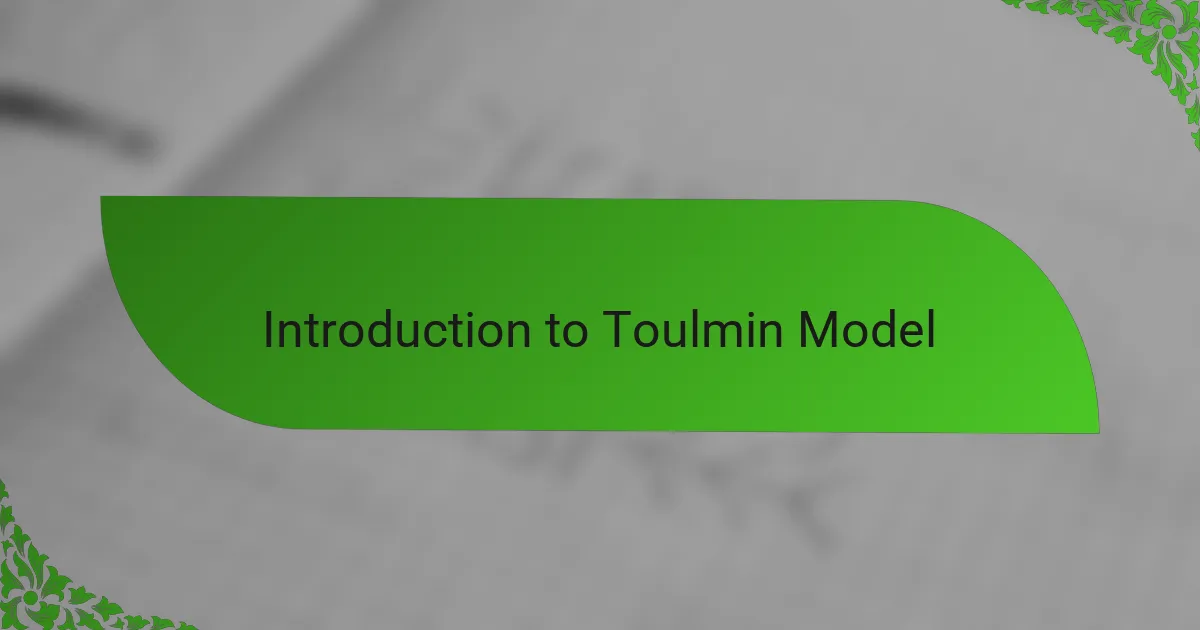
Introduction to Toulmin Model
When I first encountered the Toulmin Model, I was struck by its simplicity paired with its power. It breaks down arguments into clear parts—claim, data, warrant, and more—making complex debates feel more manageable. Have you ever felt overwhelmed trying to follow a heated discussion? That’s exactly where Toulmin’s approach helped me find clarity.
What amazed me is how the model doesn’t just focus on what someone says, but why they say it—highlighting the underlying assumptions and how evidence connects to claims. This shift in perspective changed the way I approach both writing and evaluating arguments. It felt like I gained a toolkit that turned vague opinions into well-structured reasoning.
Using the Toulmin Model felt like discovering the blueprint beneath a building I thought I understood. It gave me confidence to dissect arguments without losing sight of their purpose. For anyone diving into philosophy or critical thinking, understanding this model isn’t just helpful—it’s essential. Wouldn’t you agree that seeing the architecture of reasoning is a game changer?
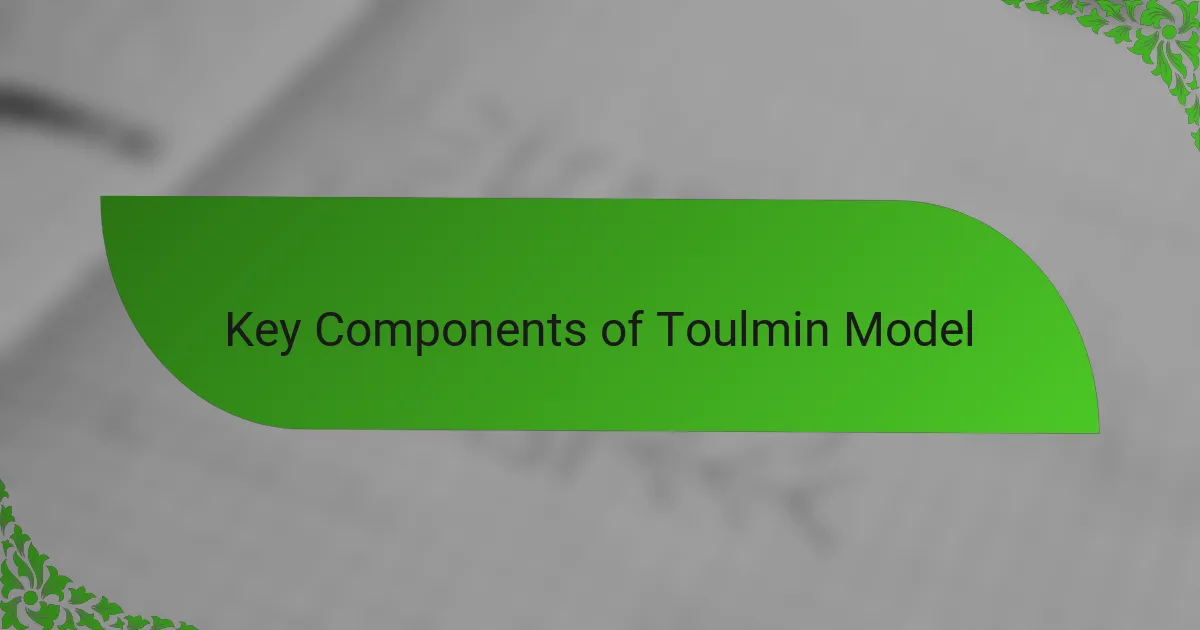
Key Components of Toulmin Model
One thing that really stood out to me about the Toulmin Model is its focus on six key components: claim, data, warrant, backing, qualifier, and rebuttal. When I first tried to identify each part in an actual argument, it felt like piecing together a puzzle. Have you ever noticed how a claim alone can feel flimsy without the right support? That’s the magic of data and warrants—they give the claim its sturdy foundation.
I remember wrestling with the warrant component because it’s often the unstated link between data and claim. Understanding warrants taught me to look beyond surface-level statements and ask, “Why does this data actually support the claim?” This shift made me more skeptical but also more appreciative of solid reasoning. It felt like lifting a veil to see the assumptions that often hide in plain sight.
Finally, the qualifier and rebuttal opened my eyes to argument flexibility. Not every claim is absolute; qualifiers show the strength of a claim, like saying “probably” or “usually.” Adding rebuttals felt like giving arguments room to breathe, acknowledging that exceptions or counterpoints exist. Have you found that this makes discussions less combative and more honest? In my experience, it definitely does.
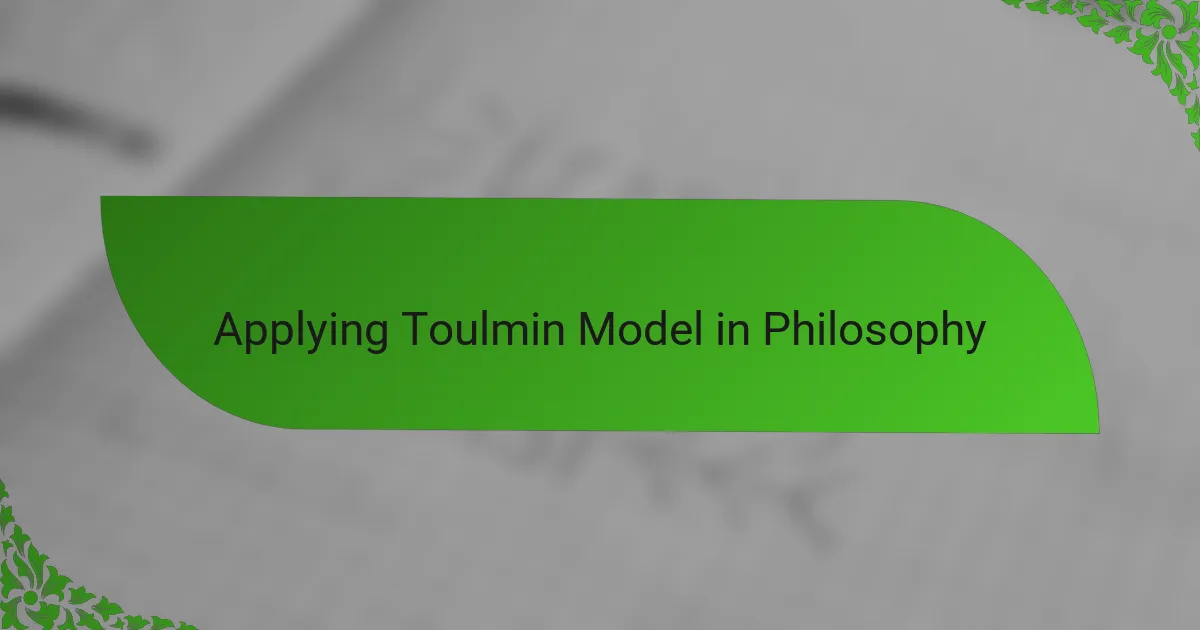
Applying Toulmin Model in Philosophy
When I began applying the Toulmin Model in philosophy classes, I realized it transformed abstract debates into something tangible. Instead of getting lost in endless back-and-forth, I could pinpoint exactly where an argument was strong or weak. Have you ever felt stuck trying to critique a philosophical position and wished for a clear roadmap? That’s what happened to me, and the Toulmin framework was that guide.
What surprised me most was how using warrants made me question assumptions I hadn’t even noticed before. For instance, when discussing moral theories, identifying the warrant forced me to clarify why certain principles were taken for granted. This deepened my understanding and made my own arguments more precise and less surface-level.
I also found the qualifier and rebuttal components invaluable when exploring philosophical skepticism. Recognizing that not all claims are absolute helped me accept uncertainty without abandoning reason altogether. Have you tried embracing this uncertainty in your own thinking? Doing so brought a refreshing openness to discussions that I hadn’t expected before using Toulmin’s model.
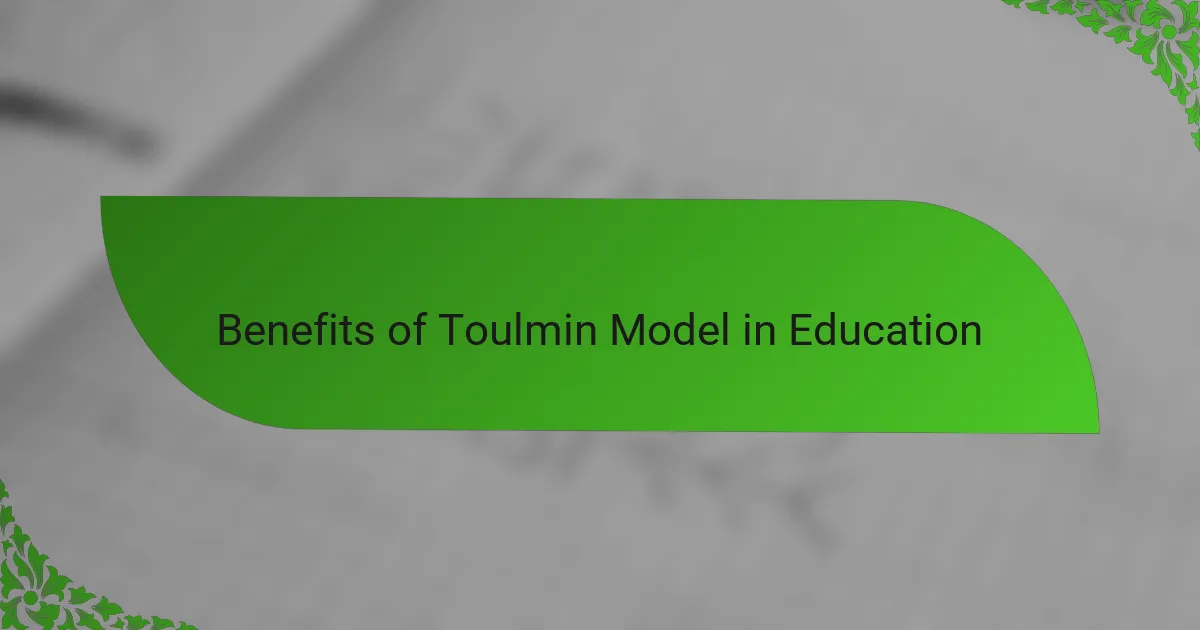
Benefits of Toulmin Model in Education
One major benefit I found is how the Toulmin Model encourages critical thinking by breaking arguments into manageable parts. It helped me—not just in spotting weak spots in others’ reasoning, but in sharpening my own arguments too. Have you noticed how much clearer your points become when you can label each part and see how they fit together?
Another thing I appreciate is how the model fosters open-mindedness. When I used qualifiers and rebuttals, I realized that arguments don’t need to be black-or-white battles. This made discussions feel more honest and less confrontational, which made learning more enjoyable and less stressful. Don’t you think education should feel that way—encouraging understanding rather than just winning a debate?
Lastly, the practical nature of Toulmin’s framework made philosophy feel accessible and relevant. I remember moments when dense texts seemed intimidating, but breaking down arguments with Toulmin gave me a concrete tool to tackle them. It transformed abstract concepts into real skills I could use both in class and everyday conversations. Isn’t that kind of practical learning what education is really about?
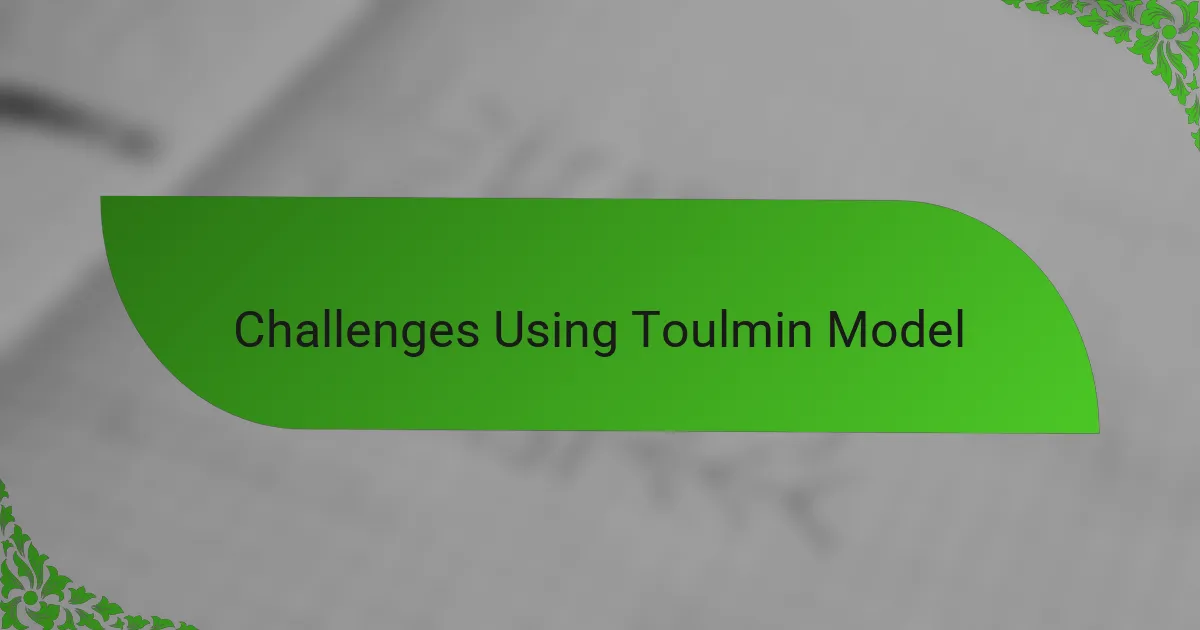
Challenges Using Toulmin Model
I found one of the biggest challenges with the Toulmin Model was wrestling with the warrant component. It’s often implied rather than stated outright, and early on, I struggled to identify those hidden links between data and claim. Have you ever tried to explain why a piece of evidence actually supports a point, only to realize it’s not always straightforward? That moment made me stop and rethink my assumptions more carefully than before.
Another difficulty I faced was balancing the qualifier and rebuttal sections. It felt awkward at first to admit that my claim wasn’t absolute or could be challenged. I wondered, “Am I weakening my argument by acknowledging exceptions?” But through practice, I realized this honesty actually made my reasoning more credible. Did you notice how embracing uncertainty can sometimes be the strongest move in a debate?
Lastly, applying the Toulmin Model in real-time conversations was tougher than writing. Breaking down spontaneous arguments into all six parts on the spot demands quick thinking. I remember feeling overwhelmed trying to analyze debates live without missing anything important. Have you ever wished for a pause button during heated discussions? That experience taught me patience and the need for gradual mastery rather than expecting perfection from the start.
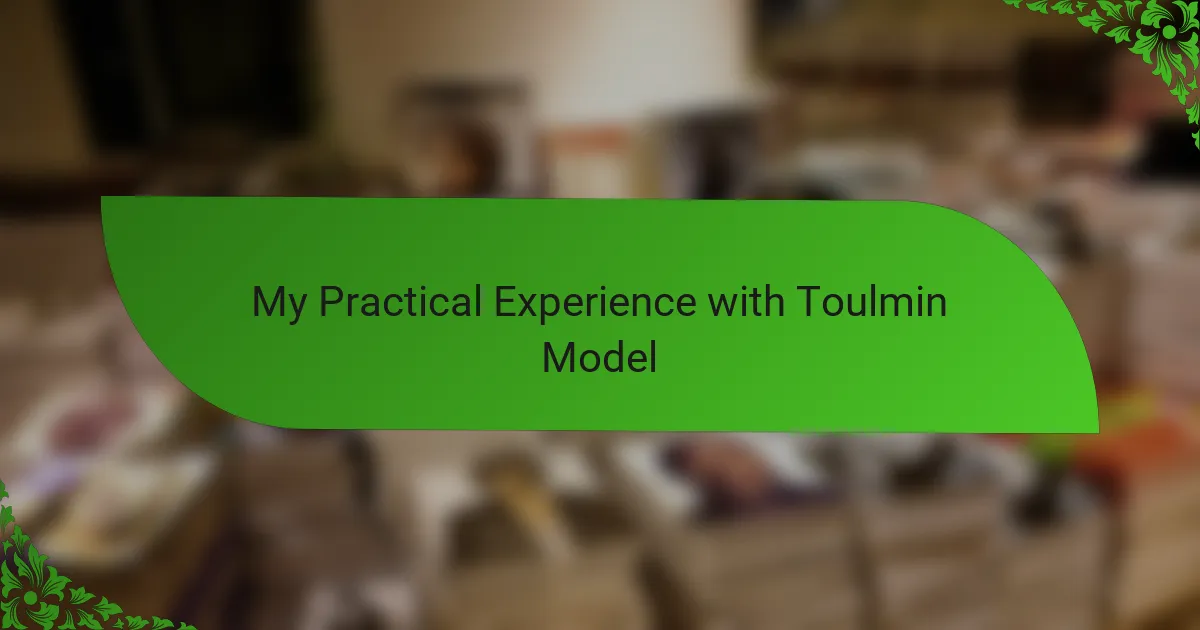
My Practical Experience with Toulmin Model
When I first put the Toulmin Model to work in my own debates, I was surprised by how it sharpened my focus. Instead of flinging arguments out there blindly, I started structuring my points deliberately—making sure each claim stood on solid data and a clear warrant. Didn’t it feel like having a thoughtful conversation rather than just trading opinions? That shift made me more confident and clear-headed.
One particular instance that sticks with me was during a heated discussion on ethics. Using the rebuttal piece gave me the courage to acknowledge valid counterarguments without feeling defeated. It was liberating to admit, “Yes, this claim has limits,” because it actually strengthened the overall argument. Have you ever experienced that refreshing moment of intellectual honesty that changes the tone of a debate? For me, Toulmin’s model made that not only possible but natural.
On the flip side, I remember occasions when real-time conversations challenged my Toulmin skills. Trying to analyze every part of an argument on the fly felt like juggling too many balls at once. However, this struggle reminded me that mastery takes time and patience—no one expects perfection immediately. Have you found that with complex tools, the hardest moments often lead to the deepest learning? That’s exactly how I grew with Toulmin’s approach.
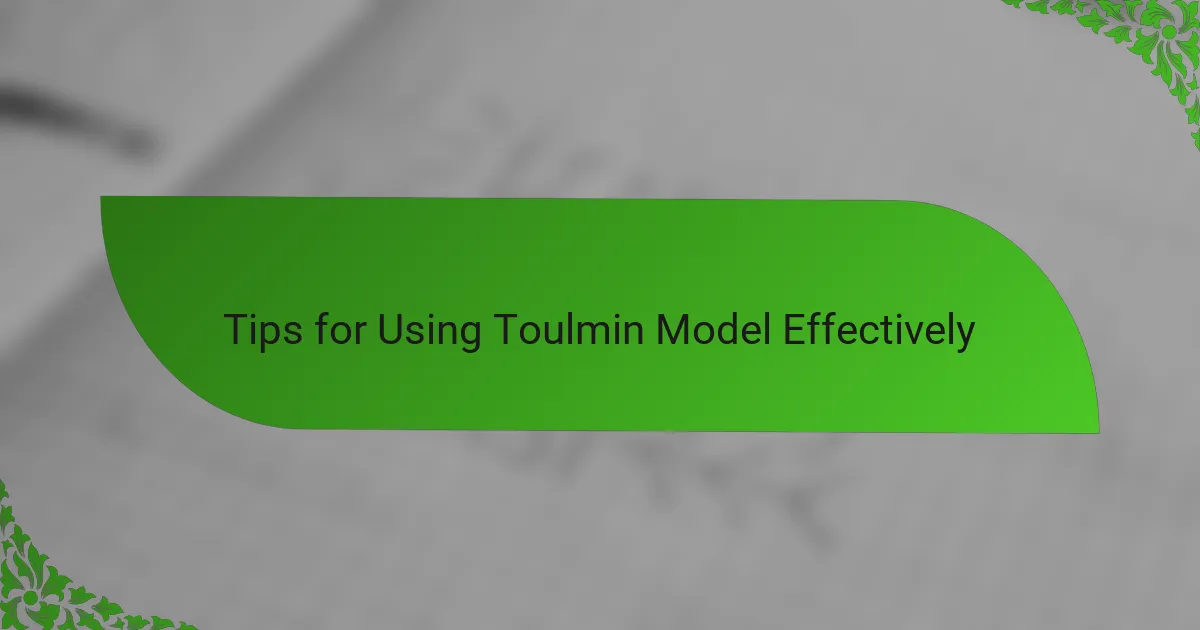
Tips for Using Toulmin Model Effectively
One tip I learned early on is to pay close attention to the warrant—the hidden assumption that links your data to your claim. Initially, I underestimated this step and found my arguments falling apart when others questioned that connection. Have you ever been caught off guard because your evidence didn’t clearly back your point? Focusing on warrants helped me build stronger, more convincing arguments.
Another thing that made a big difference was embracing qualifiers and rebuttals without fear. At first, I worried that admitting exceptions or uncertainties weakened my stance, but I soon realized it did the opposite. Isn’t it refreshing when you can honestly say, “This usually holds true, but here’s where it might not,” and still come across as credible? This honesty opened up richer conversations and reduced defensive debates in my experience.
Lastly, practice is key—especially when applying the model in real-time discussions. I remember feeling overwhelmed trying to dissect every part on the spot, like juggling too many balls. Have you ever wished for a ‘pause’ button in live debates? Over time, patience and repeated use helped me respond more fluidly without losing the structure Toulmin’s model demands. It showed me that mastery doesn’t come overnight, but each attempt moves you closer.